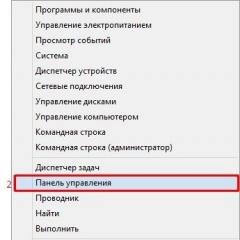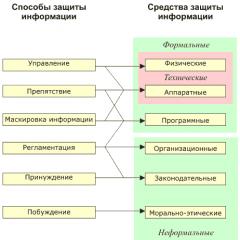The Windows 7 Task Scheduler service does not start. The Task Scheduler service is missing or missing - a solution. Create a simple task
Often, during the action of viruses or, let's say, not quite correct user actions, it happens that some services disappear or do not work.
This happens especially often with the "Task Scheduler" service, because. this service is necessary for the correct operation of, for example, an antivirus (and possibly some others, I have not checked). As a rule, in the same way, all the creators of lightweight builds of Windows (ala Game Edition, ZverCD, etc.) often kill such services, considering them superfluous, and they kill not just by changing the startup parameter from "Automatic" to "Disabled", but generally cutting out the service from the system so that it is not displayed either through or in the list of services in the Administration panel.
In this article, I offer you a solution and present a small .reg file that corrects this misunderstanding, namely, returns the service to its place, even if it is not on the list and cut out by folk "craftsmen" from the system or changing its startup parameters is not available as a result action of a particularly harmful virus.
Go.
Using the Registry to Restore a Service
Actually, everything is simple.
The contents of the file are as follows:
Windows Registry Editor Version 5.00
"Description"="Allows you to configure the schedule for automatic execution of tasks on this computer. If this service is stopped, these tasks cannot be started at the scheduled time. If this service is disabled, any services that explicitly depend on it cannot be started. "
"Type"=dword:00000020
"Start"=dword:00000002
"ErrorControl"=dword:00000001
"ImagePath"=hex(2):25,00,53,00,79,00,73,00,74,00,65,00,6d,00,52,00,6f,00,6f,00,\
74.00.25.00.5c,00.53.00.79.00.73.00.74.00.65.00.6d \
00,76,00,63,00,68,00,6f,00,73,00,74,00,2e,00,65,00,78,00,65,00,20,00,2d,00, \
6b,00,20,00,6e,00,65,00,74,00,73,00,76,00,63,00,73,00,00,00
"DisplayName"="Task Scheduler"
"Group"="SchedulerGroup"
"DependOnService"=hex(7):52,00,70,00,63,00,53,00,73,00,00,00,00,00
"DependOnGroup"=hex(7):00.00
"ObjectName"="LocalSystem"
"FailureActions"=hex:80,51,01,00,00,00,00,00,00,00,00,00,03,00,00,00,2e,00,03,\
00,01,00,00,00,70,17,00,00,01,00,00,00,60,ea,00,00,00,00,00,00,00,00,00,00
"ServiceDll"=hex(2):25,00,53,00,79,00,73,00,74,00,65,00,6d,00,52,00,6f,00,6f,\
00,74,00,25,00,5c,00,73,00,79,00,73,00,74,00,65,00,6d,00,33,00,32,00,5c,00, \
73,00,63,00,68,00,65,00,64,00,73,00,76,00,63,00,2e,00,64,00,6c,00,6c,00,00, \
00
"ServiceMain"="ScheduleServiceMain"
"Security"=hex:01,00,14,80,90,00,00,00,9c,00,00,00,14,00,00,00,30,00,00,00,02,\
00,1c,00,01,00,00,00,02,80,14,00,ff,01,0f,00,01,01,00,00,00,00,00,01,00,00, \
00,00,02,00,60,00,04,00,00,00,00,00,14,00,8d,01,02,00,01,01,00,00,00,00,00, \
05,0b,00,00,00,00,00,18,00,9d,01,02,00,01,02,00,00,00,00,00,05,20,00,00,00, \
23,02,00,00,00,00,18,00,ff,01,0f,00,01,02,00,00,00,00,00,05,20,00,00,00,20, \
02,00,00,00,00,14,00,fd,01,02,00,01,01,00,00,00,00,00,05,12,00,00,00,01,01, \
00,00,00,00,00,05,12,00,00,00,01,01,00,00,00,00,00,05,12,00,00,00
Why do we need it?
Well, someone out of professional interest, someone just out of curiosity, but in our case it will come in handy if you can’t download the file. Then, as you probably guessed, you can create it yourself. For this:
- We create a text document - a regular .txt - and, having opened it, paste the above content there
- Save changes to the document and open "My Computer"
- We go along the path "Tools" - "Folder Options ("Folder Options" in the case of Windows 7) and uncheck "Hide extensions for known file types"
- Click on the apply button and return to the newly created file
- Right click on it and select "Rename". Now we can change not only the name, but also
The Task Scheduler is an important tool in Windows that allows users to schedule programs and certain processes to run. But lately I found that the Scheduler is not working on my Windows 10 Pro system. For example, if I try to open it, I get a message that the Task Scheduler service is unavailable.
Here is the error message:
The Task Scheduler service is unavailable. Task Scheduler tries to reconnect
Although the error message says that the Task Scheduler automatically connects to its service, it actually doesn't. As a result of this, you keep getting this error message when you open Task Scheduler. launch SFC/SCANNOW Commands with admin privileges on the command line might help. If your system is getting the same error, here is how to fix it:
How to Fix: Task Scheduler Service Not Available in Windows 10
Method 1 - Using the Services snap-in
1. Press Win + R and enter the command services.msc in the dialog box Run, click Enter to open the service management tool.
2. In the window Services, scroll down and find the service Task Scheduler. Double click on the service to open the properties window.

3. Now in the properties window set the startup type Automatically, and then click the button Run, to start the service. Click Apply then OK. Close the service control tool and restart your PC.

After restarting the machine, the error should be resolved.
Method 2 - Using the Registry Editor
Disclaimer: Further steps will involve registry manipulation. Errors when modifying the registry can affect the operation of the system negatively. So be careful when editing registry entries. Be sure to create a backup.
1. Press Win + R and type regedit in the dialog box Run. Click the button OK.

2. In the left pane of the Registry Editor, navigate to the following registry key:
HKEY_LOCAL_MACHINE\SYSTEM\CurrentControlSet\Services\Schedule
3 . Open section Schedule and find in it a parameter named Start DWORD (32 bits). Double click on it and change the key value to 2 .

4. By changing the parameter value, with 4 on the 2 press the button OK. Close Registry Editor and restart your computer. After rebooting, check and you will see that the problem is solved.
Method 3 - Removing a corrupted task scheduler cache.
- Open Registry Editor.
- Navigate to the following registry key:
- Click on the Tree registry key and expand this registry key.
- Now rename all the folders in the Tree section, adding for example, to the name .old

- Open Task Scheduler to see if there is an error message or not.
- If the error message does not appear, this indicates that the entry in this registry key is corrupted, we must find the corrupted entry.
- Let's return one of the folders to its previous name, and run the Task Scheduler again to see if there is an error message or not.
- In this way, you will find which of the tasks can be damaged, and causes the error "Task Scheduler Service is not available." In most cases this is an issue with the Adobe Flash Player Updater and renaming seems to fix the error, but you should be able to fix this issue by following the steps above.
- Now remove the entries that are causing the Task Scheduler error and the issue will be resolved.
Hope this helps!
How to restore the task scheduler?
Master's response:
The purpose of the task scheduler in Windows is to organize the work of programs and the system according to the accepted schedule. You can set up auto-launch of certain applications at the required time - for example, a notepad in which a birthday greeting is written to a colleague. Task schedulers are built into operating systems, so they cannot be downloaded separately or connected.
We need to have: - administrator rights.
Let's make sure that there are system files of the "Scheduler" on the computer (for this we go to the directory C:\Windows\System32). These files include schedsvc.dll, mstask.dll and schedcli.dll, as well as the main one - schtasks.exe. If these files are missing, we will try to manually “put” them into this folder. To do this, copy them from the Windows disk. If system files are not displayed on our computer, then we will turn on the display (we use the “Folder View” tab for this).
Let's check if the system files and folders are intact. The sfc /scannow command entered at the command line will start checking the contents of system folders for integrity. If signs of file corruption are found, the system will restore them from a backup. Let's use the built-in system restore. Let's roll back its state to the time when the Scheduler was still on the computer and working. To do this, select a restore point. The recovery utility can be found in the start menu. Here you need to select the line "All Programs", in the window that opens - "Maintenance", and there find and click on "System Backup and Restore".
If the system files are seriously damaged, it is best to reinstall Windows after copying the necessary data to another partition. You can do it yourself if you have a licensed disc with the system. It is necessary to try to create backup copies of all information located on a personal computer.
There are many organizer programs that allow you to create a virtual program schedule. Let's use a search engine and download programs from the Internet. Do not neglect the messages of the anti-virus program, otherwise there is a risk of introducing viruses into the system. It is also recommended to use licensed anti-virus programs to fully protect your personal computer.
The Task Scheduler, also sometimes referred to as the Task Scheduler, is a tool built into Windows that allows you to automatically start programs and perform certain actions (such as restarting or shutting down your computer). In this article, we will talk about where the Task Scheduler is located, how to open it in Windows 7 and Windows 10, and how to use it.
If you are interested in directly finding the Task Scheduler, then it is located in the WINDOWS \ System32 folder, and its executable file is called Taskschd.msc. You can go to this folder and launch the Task Scheduler by double-clicking on it, just like any other program.
By the way, to quickly open the WINDOWS\System32 folder, you can use . To do this, press the key combination Windows + R, enter the command "%SYSTEMROOT%\System32” and press the Enter key.

How to open Task Scheduler
There are many different ways to open the Task Scheduler in Windows 7 and Windows 10. The easiest option is to simply use the search in the Start menu. To do this, open the Start menu and type in the search query "Task Scheduler".

In addition, you can run the "Taskschd.msc" command. To do this, press the key combination Windows + R to open the "Run" window, enter the command "Taskschd.msc" and press the Enter key.

You can also Task Scheduler. To do this, go to the Control Panel and go to the "System and Security - Administrative Tools" section. Various tools for managing the Windows operating system will be available here. Among other things, the Task Scheduler will also be available here.

How to use Task Scheduler
Task Scheduler can be used to solve a variety of tasks. For example, it can be used to run programs, scripts, turn off the computer, and much more. The Task Scheduler interface consists of three parts: left, center and right. The so-called "Task Scheduler Library" is available on the left side of the interface. All tasks that have been added to the Scheduler are concentrated here. Navigating through the folders of the library, you can see all the tasks of the Scheduler.

By selecting one of the Library folders, a list of tasks that are in this Folder will appear in the central part of the interface. By selecting one of the tasks with the mouse, you can view more detailed information about this task. In order to start, stop or disable the execution of a task, right-click on it.

On the right side of the interface there is a block with buttons. Buttons for creating new and setting up old tasks are available here. For example, in order to create a new task using the wizard, you need to click on the "Create a simple task" button.

This will open the task creation wizard. With its help, it is quite simple to create a new task and configure the action that it should perform. You can read more about the process of creating a new task in the article about.

In addition, other buttons are available on the right side of the interface:
- Create task - creating a task without using the wizard (manual setting of all parameters).
- Import task- import tasks that you have previously exported. It can be used if you need to configure the execution of some action on several computers (for example, launching an antivirus or blocking certain sites).
- Show all running tasks- allows you to see a list of all tasks that are currently running.
- Enable All Job Log- allows you to activate task scheduler logging (all actions performed by the task scheduler are recorded in the log).
- Create folder - used to create your own folders on the left side of the interface.
- Delete Folder - Used to delete folders on the left side of the interface.
- Export - allows you to export the desired task for use on other computers or after reinstalling Windows
As part of a series of articles about Windows administration tools that few people use, but which can be very useful, today I will talk about using the Task Scheduler.
In theory, the Windows Task Scheduler is a way to start some program or process when a certain time or condition occurs, but its capabilities are not limited to this. By the way, due to the fact that many users do not know about this tool, removing from startup malware that can register their launch in the scheduler turns out to be more problematic than with those that register themselves only in the registry.

The task scheduler has approximately the same interface as other administration tools - on the left side there is a tree structure of folders, in the center - information about the selected item, on the right - the main actions on tasks. Access to the same actions can be obtained from the corresponding item of the main menu (When a specific task or folder is selected, the menu items change to those related to the selected item).
Basic actions in the task scheduler
In this tool, the following actions on tasks are available to you:
- Create a simple task- creating a task using the built-in wizard.
- Create a task- the same as in the previous paragraph, but with manual configuration of all parameters.
- Import task- import of a previously created task that you exported. It may come in handy if you need to configure the execution of a certain action on several computers (for example, launching an antivirus scan, blocking sites, etc.).
- Show all running tasks- allows you to view a list of all tasks that are currently running.
- Enable All Job Log- Allows you to enable or disable task scheduler logging (records all activities triggered by the scheduler).
- Create a folder- serves to create your own folders in the left panel. You can use it for your own convenience, so that it is clear what and where you created.
- Delete folder- deleting the folder created in the previous paragraph.
- Export- allows you to export the selected task for later use on other computers or on the same one, for example, after reinstalling the OS.
In addition, you can call up a list of actions by right-clicking on a folder or task.
By the way, if you have suspicions about the presence of malware, I recommend that you look at the list of all running tasks, this may be useful. It will also be useful to enable the job log (disabled by default), and look into it after a couple of reboots to see what jobs were running (to view the log, use the "Journal" tab, selecting the "Task Scheduler Library" folder).

The Task Scheduler already contains a large number of tasks that are necessary for the operation of Windows itself. For example, automatic cleaning of the hard disk from temporary files and disk defragmentation, automatic maintenance and checking of the computer during idle time, and others.
Create a simple task
Now let's see how to create a simple task in Task Scheduler. This is the easiest way for novice users, which does not require special skills. So, select the item "Create a simple task".

On the first screen, you will be asked to enter a name for the task and optionally a description.

The next item is to choose when the task will be performed: you can execute it by time, when you log into Windows or turn on the computer, or when an event occurs in the system. When you select one of the items, you will also be prompted to set the execution time and other details.

And the last step is to choose what action will be performed - launching the program (you can add arguments to it), displaying a message, or sending an e-mail message.
Creating a task without using a wizard
If you need more fine-grained customization of tasks in the Windows Task Scheduler, click "Create a task" and you will find a lot of parameters and options.

I will not describe in detail the complete process of creating a task: in general, everything is quite clear in the interface. I will note only significant differences compared to simple tasks:

Despite the fact that there are a large number of different options, I think it will not be difficult to understand them - they are all called quite clearly and mean exactly what they say in the title.
I hope that the above can be useful to someone.



